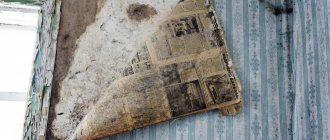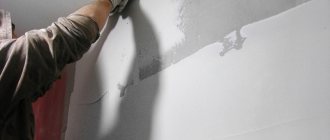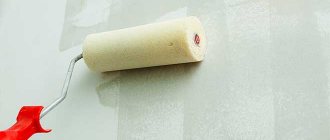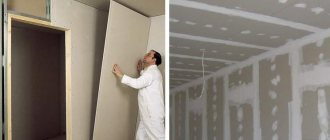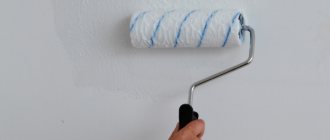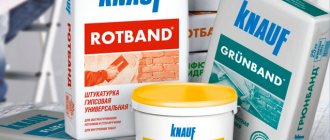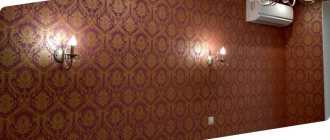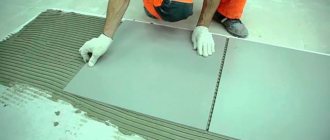To remove grease stains on a vinyl or non-woven wall surface, you can use various methods to remove stains.
Regular dishwashing or household detergent. soap will help eliminate grease stains. Removing marks using this method is very simple - prepare a soap solution, soak a sponge in it and wipe the wall. There should not be a trace of dirt left on the vinyl.
Cleaning rules
- Painted surfaces, wallpaper, parquet and laminate should not be over-wetted with water - this can cause them to swell, peel, and change color. Therefore, a washing vacuum cleaner is used to clean laminate and parquet floors. For all other materials that allow wet cleaning, it is carried out manually, and each time the rag or sponge is thoroughly wrung out of excess moisture, and then all washed areas are wiped dry.
- It is easier to remove any stains from almost any coating while they are fresh, so you should never delay cleaning.
- Home remedies for removing stains are used only when special stain removers are not available. In all other cases, special products have an advantage over soda, bleach and potassium permanganate, since they are designed taking into account the characteristics of certain coatings and are able to remove contaminants with the least damage to them.
- In specialized stores and construction supermarkets you can find cleaning products for parquet, laminate, various kitchen surfaces, glass and even wallpaper. Coating sellers often offer coating care products, as they say, in one package. You should not refuse such an offer: it is advisable to have these products in your home arsenal.
Removal using folk remedies
When using folk remedies to remove greasy stains from wallpaper, it is recommended to test each composition on an inconspicuous area.
Universal cleaning methods
To get rid of stains, you need:
- Mix tooth powder and water until the consistency of thick sour cream.
- Apply the mixture to the contaminated area and leave for 12 hours.
- Remove the mixture with a dry toothbrush with soft bristles.
A mixture of tooth powder and pure alcohol helps remove old stains from paper wallpaper. The procedure in this case is similar.
If greasy stains appear near sockets and switches, you should use a school eraser. To quickly clean such contaminants, you can take gasoline, soak a napkin in it and apply the latter to the problem area for 1–2 minutes.
Watch the video to see how quickly and easily you can remove stains from wallpaper.
In addition, heat treatment is used to clean any wallpaper from oil stains. To do this, heat the iron to maximum temperature and iron a cloth placed on the contaminated area.
Removing problem spots
If greasy marks appear on vinyl or non-woven fabric, use table vinegar. In this case, the material is cleaned according to the following algorithm:
- Mix in 1 tbsp. l. vinegar a few grains of potassium permanganate.
- Soak a cotton pad in the mixture and wipe the stain.
- Wash the walls with a damp sponge to remove the vinegar smell.
A simple way to wash wallpaper.
Vinegar should not be used on paper wallpaper. This mixture will corrode the material.
Vinegar works well on both fresh and old stains. However, it is not recommended to intensively rub the contaminated area with this solution.
Cleaning stubborn stains
But previously the use of fuel was considered in relation to paper-based material. In this case, gasoline acts as an aggressive agent that removes stubborn stains. To get rid of such contaminants, you need:
- Soak a rag or sponge in gasoline.
- Rub the stain with a little force, trying to remove the grease.
- Leave the problem area for 5-10 minutes so that the gasoline has time to absorb into the material.
- Wash the wall several times with soapy water to get rid of the smell of gasoline.
Several effective ways to clean stains from wallpaper.
The described method is suitable for cleaning wallpaper with water-repellent properties (non-woven, paintable and vinyl).
Due to the fact that gasoline has an aggressive effect on various materials, before starting the procedure it is recommended to test the effect of fuel on color and design in an inconspicuous area.
Delicate cleaning
To gently clean oil stains you need:
- Mix corn or potato starch in water to make a paste.
- Apply the paste to the stain and leave for 7 minutes.
- Remove the slurry with a damp cloth, wiping the material several times.
This method is used to clean fresh grease stains.
Due to the fact that water is used to remove oil traces, it is prohibited to use this method on paper wallpaper.
How to remove greasy stains on vinyl and non-woven wallpaper
Vinyl and non-woven trellises are very practical compared to paper ones. They are waterproof and resistant to friction cleaning. However, it should be noted that even such coatings will be difficult to get rid of old greasy stains.
IMPORTANT! Any stains, even on heavy-duty wall covering materials, must be removed while they are still fresh. Otherwise, you may not be able to completely get rid of dirty marks.
- Fresh oil stains from wallpaper can be easily removed by wet cleaning. To do this, you will need a warm soapy solution and a soft sponge. The detergent composition is prepared from any product: soap shavings, washing powder, liquid soap. Soak the soft side of the sponge in the resulting solution and gently wipe off the dirt. When finished cleaning, blot the treated area with dry wipes.
Getting rid of stains on clothes using improvised means
Today, the household chemicals market is replete with a variety of stain removers, which differ in cost, but not always in quality. Therefore, it is necessary to pay special attention to a variety of available means that can rid clothes of the most difficult and old stains.
| Tags: how to remove old stain, greasy stain | Comments (2)CommentIn the quote book or community |
How to remove stains from the wall, yellow and greasy stains on the wall
Streaks and dirt on the walls cause us a lot of problems.
To effectively eliminate them, we must first determine the cause of their occurrence. If these are stains from baby food that children have smeared on the wall, then they can be easily removed. However, if the discoloration is the result of moisture and mold, then such stains are more difficult to remove. Even painting walls with stains does not make sense without eliminating the cause of their occurrence. The basic principle before starting painting is that the walls must be dry. It doesn't matter what materials they are built from. They should not be wet. If dirt appears as a result of dampness and mold, you must first dry the walls.
- Fight against moisture and fungi
- How to remove stains on the wall from mold and mildew
- How to remove stains from the wall - hot water, alcohol, gasoline
- What and how to paint stained walls
- How to paint over a stain on a bathroom wall
Fight against moisture and fungi
There are several methods for effectively drying surfaces. Namely mechanical and chemical methods. Each gives much faster results than natural drying, such as opening windows and doors. By using modern technology, you can definitely save time.
The invasive method consists of using special heaters. In this case, however, it is necessary to ensure sufficient ventilation in the rooms.
Invasive methods include chemical drying. How to dry a surface using chemical methods? This method involves drilling holes, which are filled with liquid cement with the addition of special activators, which, spreading inside, form a waterproof barrier to moisture. It should be recognized that chemical methods are more effective than mechanical ones. They can also be used regardless of the type of material and degree of humidity.
How to remove stains on the wall from mold and mildew
After drying, it is important to destroy existing mold and protect the surface from microbial growth. First, you must physically remove black stains on walls caused by fungi by treating the dark spots on the wall at least twice with a fungicide spray, each time waiting until the surface is completely dry. After drying, areas infected with fungus should be painted with special paint. This can be “Dekoral Renostyl” paint for dirt or the well-known “Śnieżka” for dirt and stains. Only after such protection can the surfaces be ready for further work.
What causes spots?
There are several reasons for the appearance of greasy stains on walls. These include small children with unwashed hands, pieces of food falling on the surface, drops of oil flying out of the frying pan when cooking food, and simple carelessness. There are several ways to eliminate such contaminants and they depend on the cause of the stains, as well as their composition. The effectiveness of the methods also depends on the material used to decorate the wall.
How to remove a greasy stain from paper, non-woven, vinyl wallpaper
There are several effective ways to remove fresh, and even not so fresh, stains. Old grease stains cannot always be removed.
Recipes for how to properly wash wallpaper from grease:
- A damp cloth with soap.
- Using starch or tooth powder, dilute the powder to the consistency of porridge, apply to the wallpaper, and leave until dry. Remove with a brush, then with a sponge.
- Using slightly diluted lemon juice or citric acid. The method is not suitable for colored wallpaper.
- Using toilet paper. Attach the paper, iron it with an iron (temperature of the working surface of the iron is 30-40 degrees). The paper will absorb grease, so periodically you need to refresh the strip of paper.
Flour or starch
You can use starch or flour. Both substances have strong absorbent properties. The products are used if the wallpaper requires careful handling. Starch or flour is placed in warm water, then the semi-liquid mass is mixed. It is applied to the stained area for about 5-10 minutes, depending on the size and quality of the stain.
When the required time has passed, the dried solution is removed with a damp sponge. After this, you need to wipe the surface with a napkin several times. The starch will absorb all the fats and remove them, and there will be no marks left on the wall.
Ammonia
The product is diluted in water (1 teaspoon per liter of liquid), treated with it, and washed off. But here you need to take care of protection, use rubber gloves and a respirator.
The effect depends not only on the product chosen, but also on how competently the cleaning is carried out. First of all, you need to prepare a stable stepladder and everything you need for washing. After that, you can start working, and to finish everything off, it is recommended to rub the surface (especially glossy) with a soft, lint-free cloth.
- Author: Natalya32
- 5
- 4
- 3
- 2
- 1
(0 votes, average: 0 out of 5) Share with your friends!
- Remove wallpaper or wash off whitewash from a contaminated surface, and clean the putty down to the plaster or drywall.
- If the surface is painted, soak the stain with a damp sponge and remove the paint and putty with a spatula.
- Allow the surface to dry completely. Then treat the surface with one of the grease or oil stain removal solutions described below.
- Rinse the surface with warm water using a sponge.
- Allow the surface to dry and then prime it with a deep penetration primer using a roller and brush.
- Wait for the soil to dry completely (24 hours).
- Paint the primed surface with oil paint in several layers and let it dry.
- Prime the area to be treated with deep soil and allow to dry (24 hours).
- Cover the surface with a layer of acrylic putty and dry for at least a day.
- Sand the putty with fine sandpaper (180-200) and prime the surface again.
- After complete drying, paint the repaired area with the same paint that was used to paint the ceiling or walls.
- Repaint the entire ceiling or wall again with your base paint.
- If you decide to apply another decorative coating or wallpaper, then you do not need to do the two previous steps.
For treatment with a solution of detergent and ammonia:
- mix one teaspoon of ammonia and any detergent,
- add the resulting solution to 100 g of warm water,
- Wipe the stain with the resulting solution until it disappears,
- Wipe the cleaned area with warm water.
For treatment with kerosene solution:
- soak a small cloth in kerosene and carefully wipe off the dirt, repeating the procedure until the oil stain disappears,
- Wipe the cleaned area with soapy warm water.


